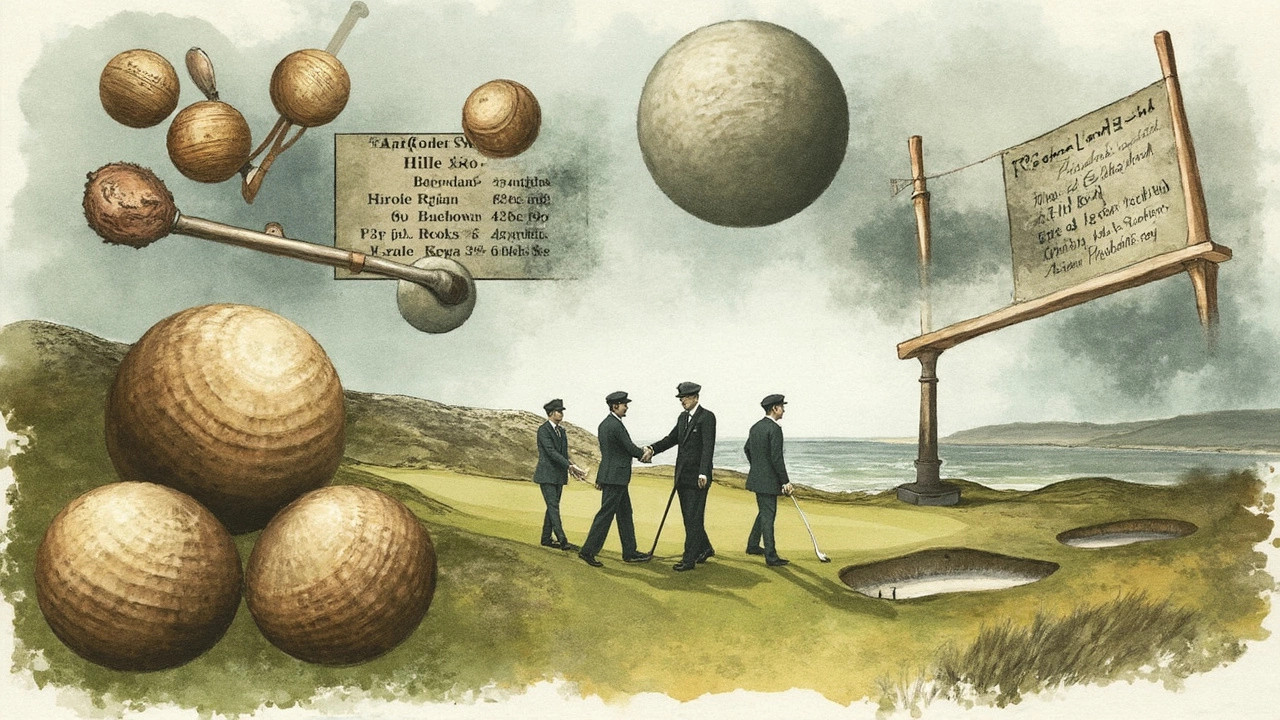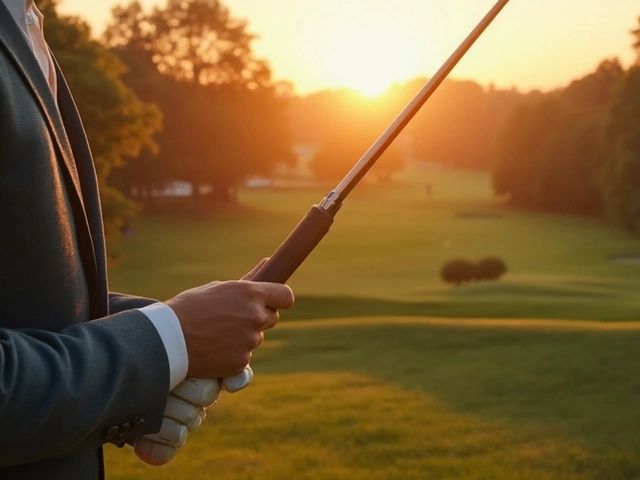Oldest Golf Course in the World: All About St Andrews Links

St Andrews Links isn’t just a golf course—it's the place that pretty much wrote the rulebook for the modern game. If you love golf, this patch of Scottish turf is like Mecca. You hear older players talk about the “home of golf” with a tone that’s half respect, half giddy excitement.
Folks have been teeing up at St Andrews since the 1400s. That’s before America was even a country. Historians have found records of golf being played here as far back as 1552, but local stories say it was even earlier. No fancy resorts, no luxury branding—just rough land along the coast and people obsessed with chasing a ball over the dunes.
Why does this matter? For starters, almost every rule, tradition, and quirk you know about golf got its start right here. Ever wondered why golf has 18 holes? St Andrews is the reason. There’s no stuffy velvet rope—they run public tee times, so regular folks actually get a shot at playing where the legends have walked.
- A Brief History of St Andrews Links
- What Makes St Andrews Unique
- Famous Moments and Records
- Visiting and Playing the Oldest Course
A Brief History of St Andrews Links
If you want to talk about golf history, you have to start with St Andrews Links. Located in the small town of St Andrews, Scotland, this stretch of grass by the sea has been shaping the sport for more than 600 years. It’s the oldest known golf course still in use. Records show that people were playing golf here as early as 1552, but there’s decent evidence the game was going strong long before that.
King James II of Scotland wasn’t a fan at first. Back in 1457, he actually banned golf at St Andrews because he thought it was distracting his soldiers from archery practice. The ban didn’t last, though—people just couldn’t stay away from the fairways. By 1552, a local charter gave townsfolk the right to play golf, basically locking in its place in sports history.
St Andrews didn’t always look like the course you see on TV. In the early days, people played over any land that wasn’t farmland or sheep pasture. The idea of 18 holes? That actually came from St Andrews, too. Originally, the course had 22 holes, but in 1764, they decided that some were too short, so they combined a few. That set the 18-hole standard that every modern course follows today.
The Royal and Ancient Golf Club, founded right there in 1754, became a kind of rule-maker for the sport. This club helped turn St Andrews into the spiritual center for golf, writing the rules, standardizing competition, and running the British Open (which is still played on the Old Course every few years).
| Milestone | Year |
|---|---|
| Earliest record of golf at St Andrews | 1552 |
| First course layout (22 holes) | Early 1700s |
| Switched to 18 holes | 1764 |
| Royal and Ancient Club founded | 1754 |
| First Open Championship at St Andrews | 1873 |
If you ever get to walk these fairways, just remember—you’re stepping on the same ground where golf got most of its rules and traditions. The Old Course at St Andrews isn’t just a relic; it’s the living source for modern golf.
What Makes St Andrews Unique
You can play a lot of golf across the globe, but nothing matches teeing off at St Andrews Links. This course is practically a living history book for golf, but there’s way more to it than just its age.
First off, St Andrews is a public course. That means it isn’t just for members or the rich and famous—you can actually play here if you book in advance. Not many courses with this kind of status offer that kind of access. The Old Course is the most famous, but the full Links is actually a set of seven courses, all built on the same stretch of Scottish coastline.
It doesn’t look or play like your usual manicured country club. Here’s what stands out:
- The fairways are super wide because they were shared by folks back in the old days playing in both directions. That’s why you get double greens—some holes share the same putting surface, which is wild when you see it in person.
- The bunkers are deep, rough, and absolutely unforgiving. The “Road Hole” bunker on 17 is probably the most famous sand trap on Earth.
- Weather is a big part of the game here. Strong winds off the North Sea and rain are just part of what makes the course so tough.
- No two rounds are ever quite the same, since the wind and pin positions constantly change how the course plays.
There are a bunch of quirky traditions, too. For example, you can play the Old Course on Sundays—but only as a public park, not for golf. Locals and tourists use it like a giant backyard for a day, which you don’t see at any other top course.
Some numbers paint the real picture of how much this place matters:
| Feature | Details |
|---|---|
| Oldest documented play | 1552 |
| Number of holes | 18 (standard set at St Andrews in 1764) |
| Courses | 7 public courses at St Andrews Links |
| Major tournaments hosted | 30+ Open Championships |
| Annual rounds played | Over 230,000 |
Honestly, playing St Andrews is about more than golf. You’re literally walking the same ground as the history’s greatest players. It’s a bucket-list experience that feels just as special for beginners as it does for pros.

Famous Moments and Records
The story of St Andrews Links is packed with big moments and firsts that shaped golf forever. This isn’t just any course—major championships have gone down here, and the world’s best golfers have either made history or had their dreams crushed on its ancient fairways.
The Open Championship, known as The Open or the British Open, has been played at St Andrews more than 30 times since 1873. Here’s a look at some of the big highlights you might want to drop at your next golf outing:
- Jack Nicklaus won two of his three Open Championships at St Andrews (1970 and 1978). After his last professional round here in 2005, he got a standing ovation on the famous Swilcan Bridge. That bridge is a rite of passage for champions.
- Tiger Woods came in and absolutely destroyed the field in 2000, winning by eight shots and finishing at 19 under par—a record that still stands for The Open at St Andrews.
- Seve Ballesteros’ fist-pumping celebration at the 18th green in 1984 is still one of the course’s most loved moments. That win became iconic for his wild grin and flair.
- In 2015, Zach Johnson won a three-way playoff to take the Claret Jug, proving that even modern players can get tripped up by St Andrews' quirks.
Let’s talk stats—the numbers speak for themselves. Here’s a snapshot of some major milestones tied to St Andrews Links:
| Moment | Year | Detail |
|---|---|---|
| First Open at St Andrews | 1873 | Tom Kidd won with a score of 179 |
| Youngest Open winner here | 1895 | Johnnie Laidlay, age 23 |
| Lowest Open score (to par) | 2000 | Tiger Woods, -19 |
| Most recent Open winner | 2022 | Cameron Smith |
The Old Course has also seen some wild weather—gusts up to 60 mph during play—and a few weird records, like David Duval shooting 83 and 65 in the same Open (1995). There’s always the chance for the unexpected. When you stand on those fairways, you’re literally in a spot where golf history gets made nearly every decade.
Visiting and Playing the Oldest Course
If you're thinking about checking St Andrews Links off your bucket list, you need to know how it works. First, the Old Course is public, not private. That means anyone can play, but it's super popular, so getting a tee time isn't a walk in the park.
Weekdays and off-seasons are your best bet for snagging a slot. They release tee times well in advance, usually in August for the next year. If you didn't plan ahead, you can try the daily ballot system. You enter your name, and they pull winners at random. It's kind of like a golf lottery, and you'd be surprised how many folks get lucky. Just remember: you need at least two golfers to enter the ballot, and you’ll want to check in before 2 p.m. the day before you want to play.
- Book a tee time online as early as possible.
- If you miss out, enter the daily ballot in person or online.
- Walking is mandatory—no carts allowed. Bring comfy shoes.
- Hire a local caddie if you want help with the brutal winds and tricky greens.
- Bring a medical certificate if you're over 65 and want to use a buggy for health reasons.
All players need a valid handicap card: 36 or lower for men, 36 for women. They're strict on dress code—nothing fancy, but collared shirts and golf shoes are expected. You’ll line up at the first tee right by the Royal and Ancient clubhouse (it’s world-famous), with tourists snapping photos. No pressure!
Here’s a little bonus info: Sundays on the Old Course are for walking and relaxing. Locals picnic and stroll—no golf allowed. That’s been the custom for ages, and it’s part of the charm.
| Old Course Fast Facts | Details |
|---|---|
| 18 Holes | Established by 1764 |
| Total Length | 7,305 yards (Championship tees) |
| Green Fees (2025 High Season) | £320 per round |
| Tee Time Ballot Success Rate | Roughly 1 in 3 (varies by season) |
| Visitors per Year | Over 230,000 rounds played annually |
If you’re in St Andrews, stop by the British Golf Museum right across the street. You’ll find wild stories, ancient clubs, and maybe get a deeper sense of why this spot is so special in golf history. Play well, and soak it in—you’re part of a tradition that’s been going for centuries.




